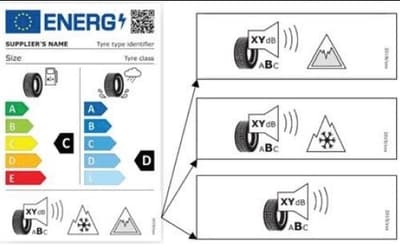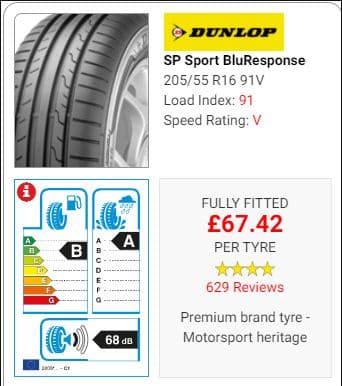New EU Tyre Label - What you need to know
In May 2021 a new set of tyre labels will come into force with the main changes being to the bands or grades. The current EU Tyre Labelling Regulation (TLR) was adopted in 2009 and came into force in November 2012. The tyre labels give consumers important information on the fuel efficiency, noise levels and wet grip performance of their tyres. As technology in tyre manufacturing continues to progress, it is important the tyre labels need to reflect these improvements and continually ‘raise the bar’ in terms of maximising safety and minimising environmental impact.
How are the tyre labels changing?
In May 2021 a new set of tyre labels will come into force with the main changes being to the bands or grades. The current system uses 7 bands for Fuel Efficiency from A (best) to G (worst), although ‘D’ is not used for passenger vehicles. The current system also uses 6 bands for Wet Grip, although ‘D’ and ‘G’ are not used for passenger vehicles. The new system will only have 5 grades from A to E and ‘D’ will now be used. The new EU tyre label will be revamped to ensure that a user will gain increased insight and awareness into the external noise levels of a tyre, the opportunity for fuel savings and also a tyre's performance in wet weather.
Below is what, in May 2021, the new EU label will look like.

Below shows the current tyre label which is featured on the Dunlop SP Sport BluResponse tyre.

What is on the new tyre label?
The new label will include some new information;
- A letter rating from A-C for the pass-by noise rating (the previous system showed a series of ‘waves’ which were not as easy to interpret).
- A marking indicating whether the tyre meets a threshold for its ice and snow grip (only relevant for these sorts of tyres, which aren’t as popular in the UK).
- All new vehicles supplied to consumers will require tyre labels.
Where will I find the new tyre label ratings?
As with the current system, retailers will need to publish these new label ratings on web sites and in any consumer literature, including sales invoices. An online European Product Database covering all brands for sale within the EU is in development.
The future for tyre labelling
When a suitable testing method, that can be used at scale, becomes available, it is thought that additional criteria relating to mileage and/or wear will eventually be added to the label.
Why are tyre labels important?
All new tyres, since 2012 come with a tyre label. A tyre label measures external noise levels, which is measured by decibels dB. Fuel efficiency is graded from A-G, meaning the higher the letter, the better fuel efficiency, decreasing fuel costs and saving you money in the process. As well as external noise levels and fuel efficiency, braking performance, specifically wet braking is also ranked using the same A-G scale as fuel efficiency. As stated earlier, once the new EU tyre label is introduced, these ratings will change from A-G to A-E.
The external noise level of a tyre is something you that should be aware of. The new EU tyre label will ensure that you will be able to decipher which tyre will be the quietest on the road. Consequently, this will greatly improve your overall driving experience. Tyres can also improve your fuel efficiency. A tyre with a higher rating for fuel efficiency will have a lower rolling resistance. This will give you better fuel economy. Wet braking is another aspect of performance which is measured on an EU tyre label. The better the rating for wet braking, the shorter the stopping distances will be in wet conditions.
Related: The complete guide to tyre labelling
Tyre labels are important as it helps give users the ability to assess three extremely important performance characteristics of a tyre. The new EU tyre label, which will be introduced in 2021, will give users further insight into specific characteristics to ensure that you can review the environmental and safety aspects of a tyre before making a tyre purchase.
During a tyre purchase, tyre labelling will provide you with further, in-depth information so you can find the best tyre to fit your needs and budget. Whether you are looking for a premium brand tyre such as Bridgestone, a mid-range brand tyre such as Avon or even a tyre from our budget range, by law a tyre label needs to be present. This is the case for any tyre purchases from a National Tyres and Autocare branch or if you are buying tyres online from the National Tyres website.
When you buy tyres from National Tyres and Autocare, our highly trained staff will be able to provide you with advice on which tyres would be best for your needs. There are a number of factors that you need to take into account when purchasing a new tyre. The best tyre for you could depend on your geographical location, the season (summer tyres, all-season tyres or winter tyres) or it can depend on how often you drive your vehicle. Tyre labelling will provide you with additional information to ensure you know everything about the tyre you are about to purchase. If you are unsure what the tyre label means, this can be explained for you in-branch by one of our staff.
Did you enjoy this blog post? |3 people found this review helpful



 Sign up for SPECIAL OFFERS
Sign up for SPECIAL OFFERS
